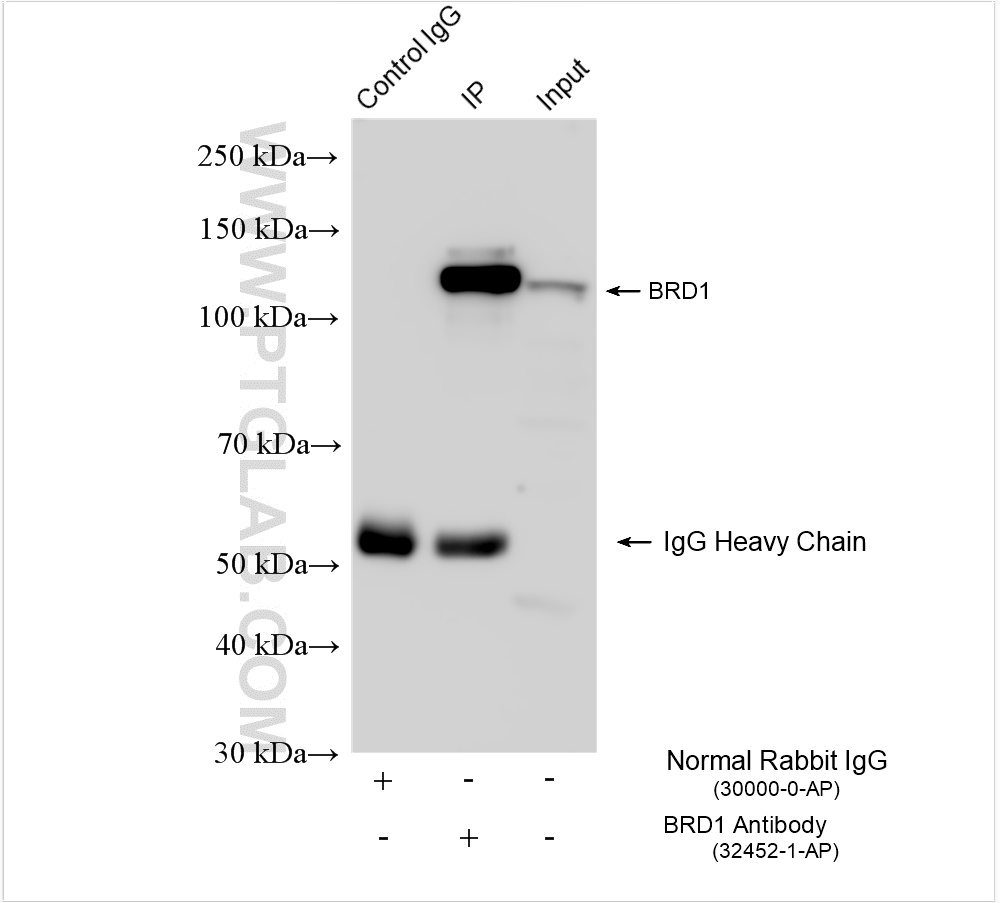验证数据展示
经过测试的应用
| Positive WB detected in | Jurkat cells, SH-SY5Y cells, SK-N-SH cells |
| Positive IP detected in | Jurkat cells |
推荐稀释比
| 应用 | 推荐稀释比 |
|---|---|
| Western Blot (WB) | WB : 1:500-1:3000 |
| Immunoprecipitation (IP) | IP : 0.5-4.0 ug for 1.0-3.0 mg of total protein lysate |
| It is recommended that this reagent should be titrated in each testing system to obtain optimal results. | |
| Sample-dependent, Check data in validation data gallery. | |
产品信息
32452-1-AP targets BRD1/BRL in WB, IP, ELISA applications and shows reactivity with human samples.
| 经测试应用 | WB, IP, ELISA Application Description |
| 经测试反应性 | human |
| 免疫原 |
CatNo: Ag37530 Product name: Recombinant human BRD1 protein Source: e coli.-derived, PGEX-4T Tag: GST Domain: 918-1070 aa of BC047508 Sequence: VLPRLETLLQPRKRSRSTCGDSEVEEESPGKRLDAGLTNGFGGARSEQEPGGGLGRKATPRRRCASESSISSSNSPLCDSSFNAPKCGRGKPALVRRHTLEDRSELISCIENGNYAKAARIAAEVGQSSMWISTDAAASVLEPLKVVWAKCSG 种属同源性预测 |
| 宿主/亚型 | Rabbit / IgG |
| 抗体类别 | Polyclonal |
| 产品类型 | Antibody |
| 全称 | bromodomain containing 1 |
| 别名 | BR140-like protein, BRD1, BRL, Bromodomain and PHD finger-containing protein 2, Bromodomain-containing protein 1 |
| 计算分子量 | 120 kDa |
| 观测分子量 | 133 kDa |
| GenBank蛋白编号 | BC047508 |
| 基因名称 | BRD1 |
| Gene ID (NCBI) | 23774 |
| 偶联类型 | Unconjugated |
| 形式 | Liquid |
| 纯化方式 | Antigen affinity Purification |
| UNIPROT ID | O95696 |
| 储存缓冲液 | PBS with 0.02% sodium azide and 50% glycerol, pH 7.3. |
| 储存条件 | Store at -20°C. Stable for one year after shipment. Aliquoting is unnecessary for -20oC storage. |
背景介绍
BRD1, also known as BRL and BRPF2, plays a key role in chromatin recruitment to modulate histone acetylation and consequently gene transcription. It interacts with a range of epigenetic modifiers, including histone acetyltransferases KAT5 and KAT7, as well as the histone-lysine N-methyltransferase KMT5B (PMID: 29453316, 38383216). It has 2 isoforms with the molecular mass of 133 kDa and 120 kDa.
实验方案
| Product Specific Protocols | |
|---|---|
| WB protocol for BRD1/BRL antibody 32452-1-AP | Download protocol |
| IP protocol for BRD1/BRL antibody 32452-1-AP | Download protocol |
| Standard Protocols | |
|---|---|
| Click here to view our Standard Protocols |

